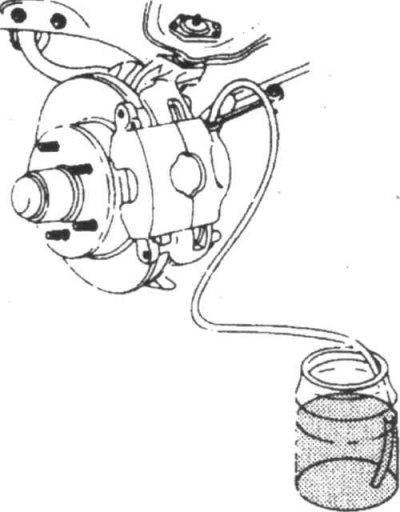Conventional brake system (without ABS)
1. If air got into the system through the reservoir or when removing the master brake cylinder, then it is necessary to bleed the brakes of all four wheels.
2. If the brake pipe was disconnected only on the brake of one, it is necessary to pump only the brake of this wheel.
3. If the brake pipe or hose was disconnected in the place between the main cylinder and any of the brakes, then it is necessary to pump the brakes of these wheels.
4. Remove vacuum from the servo booster by depressing the brake pedal several times with the engine off.
5. Fill the reservoir with brake fluid.
6. Prepare new brake fluid, a clean container partially filled with brake fluid, a plastic tube and a wrench.
7. Starting at the left rear wheel, loosen the bleeder screw, then tighten it slightly.

11.8 When bleeding the brakes, the hose must be connected to the bleeder screw and the other end dipped into the brake fluid - the escaping air will create bubbles - make sure all air is removed before moving on to the next wheel
8. Put the end of the tube on the screw and dip the other end into the brake fluid (11.8).
9. Ask an assistant to depress the brake pedal several times, then depress the pedal to the end.
10. With the pedal depressed, open the bleed screw and wait for the brake fluid to drain. Close the screw.
11. Repeat this operation until no more air bubbles come out through the tube. Then tighten the bleed screw and bleed the brake on the right front wheel, right rear wheel, and left front wheel. Keep an eye on the fluid level in the reservoir.
12. Do not use old brake fluid.
13. Fill the reservoir with brake fluid after bleeding is complete.
14. Check the operation of the brakes. The pedal should be firm when pressed and not sink. If necessary, repeat pumping.
Brake system with ABS
Attention! To bleed the ABS brake system, the engine must be running. Raise the vehicle and place it on secure stands.

11.15 Follow the bleeding order (Exhaust screw No. refers to the left rear wheel brake, screw N6 refers to the right rear wheel brake)
1. Delay valves; 2. Hydraulic modulator
15. Start the engine. Perform the operations described in points 8 and 10 and bleed the brake calipers and delay valves. Follow the order of pumping (11.15).
16. Bleed the air from the delay valve in the same way as from the brake calipers (11.15).
17. Tighten the valve bleed screws securely.
18. Bleed the hydraulic modulator located near the rear wall of the engine compartment (11.15).
19. Fill the reservoir with brake fluid after bleeding is complete.
